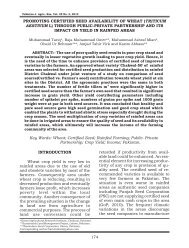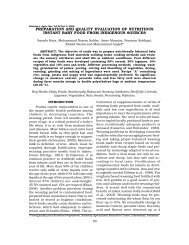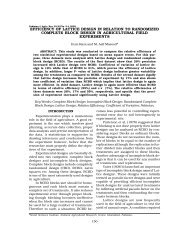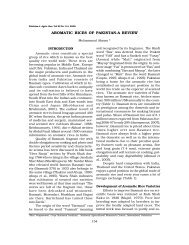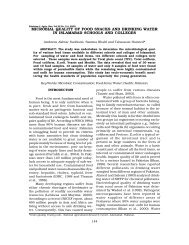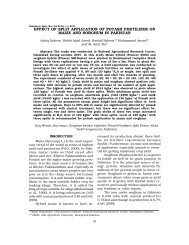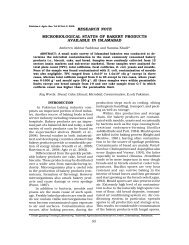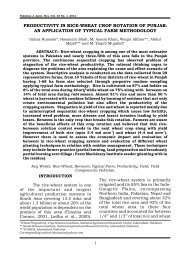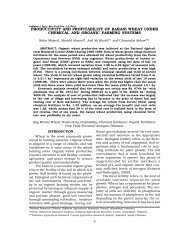assessment of goat breed improvement through distribution ... - PJAR
assessment of goat breed improvement through distribution ... - PJAR
assessment of goat breed improvement through distribution ... - PJAR
You also want an ePaper? Increase the reach of your titles
YUMPU automatically turns print PDFs into web optimized ePapers that Google loves.
Pakistan J. Agric. Res. Vol 23 No. 3-4, 2010.<br />
ASSESSMENT OF GOAT BREED IMPROVEMENT THROUGH DIS-<br />
TRIBUTION OF BEETAL BUCKS IN RAINFED POTHWAR, PUNJAB<br />
Nadeem Akmal, Hassnain Shah*, Muhammad Azam Niazi** and Waqar Akhtar*<br />
ABSTRACT: The present paper is based on the <strong>assessment</strong> <strong>of</strong> <strong>goat</strong> <strong>breed</strong> <strong>improvement</strong><br />
intervention <strong>through</strong> supply <strong>of</strong> 65 Beetal bucks in rainfed Pothwar. To<br />
judge short term impact and <strong>assessment</strong>, a survey was carried out <strong>of</strong> both buck<br />
holder and non-holder beneficiaries in six project tehsils, after one year <strong>of</strong> buck<br />
<strong>distribution</strong>. Data were collected from a sample <strong>of</strong> 38 buck holders and 31 beneficiary<br />
farmers using a structured pretested questionnaire. The main influencing<br />
factor in keeping bucks was <strong>goat</strong> <strong>breed</strong> <strong>improvement</strong>. All the sample respondents<br />
were convinced <strong>of</strong> the benefits <strong>of</strong> crosses with Beetal buck and reported that the<br />
<strong>of</strong>fsprings Beetal were <strong>of</strong> higher body weight (40% higher), good looking and well<br />
built. Regarding the suitability <strong>of</strong> Beetal with fodder and forage in the area, majority<br />
<strong>of</strong> the farmers (73%) considered it more suitable. There was a price difference<br />
<strong>of</strong> Rs. 1277 for male kids and Rs. 697 for female kids <strong>of</strong> the same age than the kids<br />
from local buck crosses. The farmers believed that the price difference was not<br />
only due to the higher weight but a better look and better structure <strong>of</strong> the Beetal<br />
<strong>goat</strong>. Farming community showed keen interest in using this intervention on a<br />
regular basis.<br />
Key Words: Beetal Buck; Goats Breed Improvement; Assessment; Survey; Pakistan.<br />
INTRODUCTION<br />
Small ruminant production constitutes<br />
an important part <strong>of</strong> agricultural<br />
economy, contributing substantially to<br />
household income and food security. Many<br />
studies on small ruminants in developing<br />
countries have indicated their importance<br />
to the livelihood <strong>of</strong> farmers (Ngategize,<br />
1989; Teufel et al., 1998; Braker et al.,<br />
2002).<br />
Among the small ruminants, <strong>goat</strong> is a<br />
multi functional animal and plays a significant<br />
role in the economy and nutrition <strong>of</strong><br />
landless, small and marginal farmers in<br />
Pakistan. Goat rearing is an enterprise<br />
which has been practiced by a large section<br />
<strong>of</strong> population in rural areas (Khan et<br />
al., 2006). Goats can efficiently survive on<br />
available shrubs and trees in adverse<br />
harsh environment in low fertility lands<br />
where no other crop can be grown (Fisher,<br />
1983).<br />
Goats possess characteristics like versatility<br />
in harvesting forage and ability to<br />
survive under adverse foraging conditions<br />
that set them apart from other livestock<br />
species. Tolerance <strong>of</strong> <strong>goat</strong>s toward bitterness<br />
plays an important role in maximizing<br />
grazing capacity and in biological control<br />
<strong>of</strong> weeds (Lu, 1988). In general, <strong>goat</strong>s<br />
have heat resistant characteristics and<br />
less susceptible to heat stress than their<br />
livestock counterparts (Lu, 1989).<br />
Goat keeping has been a traditional<br />
activity in rainfed Pothwar area <strong>of</strong> Pakistan.<br />
It is also a primary source <strong>of</strong> livelihood<br />
for people below the poverty line. Furthermore<br />
women are mainly involved in<br />
rearing the livestock as Ahmed et al. (1988,<br />
1993) had reported that majority <strong>of</strong> rural<br />
women are engaged in livestock related<br />
activities with up to 70% contribution for<br />
the sector. Freedman and Wai (1988) have<br />
pointed out that livestock production and<br />
management is mainly the job <strong>of</strong> women<br />
in barani agriculture. Masood and<br />
Mahjabeen (1989) also noted that women<br />
are engaged in 10 out <strong>of</strong> 14 livestock production<br />
and management activities in the<br />
barani areas <strong>of</strong> Pakistan. Taj et al. (2007)<br />
who studied the gender involvement in<br />
rainfed agriculture <strong>of</strong> Pothwar in Pakistan<br />
*Social Sciences Institute, National Agricultural Research Centre, Islamabad, Pakistan.<br />
**Social Sciences Division, Pakistan Agricultural Research Council, Islamabad, Pakistan.<br />
158
have reported similar trend in which<br />
women role in livestock related activities<br />
is high (60-90%). According to Pakistan<br />
Livestock Census (GoP, 2006) the total <strong>goat</strong><br />
population in Punjab was 19.83 million<br />
which was about 37 % <strong>of</strong> total <strong>goat</strong> population<br />
in the country. Isani and Baloch (1996)<br />
have described 34 <strong>breed</strong>s <strong>of</strong> <strong>goat</strong>, <strong>of</strong> which<br />
the most important are Beetal, Dera Din<br />
Panah, Kamori, Nachi and Teddy. These<br />
<strong>breed</strong>s are <strong>of</strong> varying potential in producing<br />
meat, milk and fiber. Amongst the <strong>goat</strong><br />
<strong>breed</strong>s <strong>of</strong> Pakistan “Beetal” <strong>goat</strong> is important<br />
due to its better production performance.<br />
Beetal particularly the Brown<br />
Beetal <strong>goat</strong> <strong>breed</strong> is <strong>of</strong> high repute both for<br />
meat and milk production. As Khan et al.<br />
(2006) has described that the Beetal <strong>breed</strong><br />
is used for meat and milk production. The<br />
males have long twisting horns. The <strong>breed</strong><br />
is similar to the Jamnapari but is superior<br />
to it in that it is more prolific and more<br />
easily adaptable to different agro ecological<br />
condition. Males are raised especially<br />
as sacrificial animals for slaughter on Eid-<br />
Ul-Azha.<br />
Acharya et al. (1982) reviewed the research<br />
done on the genetic aspects <strong>of</strong> <strong>goat</strong><br />
production in India and concluded that<br />
Beetal could be considered as possible improver<br />
<strong>breed</strong>s for increasing size and milk<br />
production. On the basis <strong>of</strong> purebred performance<br />
the Beetal can also be considered<br />
the best dairy <strong>breed</strong> followed by<br />
Jamunapari, Jhakrana, Barbari, Marwari<br />
and Sirohi.<br />
There are only a few examples <strong>of</strong> genetic<br />
<strong>improvement</strong> programmes (successful<br />
or otherwise) <strong>of</strong> <strong>goat</strong>s belonging to<br />
smallholders in low input production systems<br />
in developing countries (Kosgey et al.,<br />
2006). Yet, genetically-improved, efficient<br />
<strong>goat</strong>s are extremely important for these<br />
very poor <strong>goat</strong> keepers. In the rainfed<br />
Pothwar, however, the local and mix <strong>breed</strong><br />
<strong>goat</strong>s have low productivity partly due to<br />
slow growth rate which is mainly attributed<br />
to <strong>breed</strong> type, although other factors such<br />
as disease challenges, poor nutrition and<br />
management are known to contribute to<br />
this. Keeping in view the number <strong>of</strong> <strong>goat</strong>s<br />
NADEEM AKMAL ET AL.<br />
159<br />
and their contribution to the livelihood <strong>of</strong><br />
poor farmers, particularly landless and<br />
women initiatives for the <strong>improvement</strong> <strong>of</strong><br />
local <strong>goat</strong> <strong>breed</strong>s in Pothwar area were also<br />
taken <strong>through</strong> provision <strong>of</strong> Beetal Bucks in<br />
Barani Village Development Project (BVDP).<br />
The main objective <strong>of</strong> this intervention was<br />
to improve meat, milk and fiber potential<br />
<strong>of</strong> native <strong>goat</strong> <strong>breed</strong>s <strong>through</strong> cross<strong>breed</strong>ing<br />
with brown Beetal. A study was planned<br />
specifically for <strong>assessment</strong> <strong>of</strong> <strong>breed</strong> <strong>improvement</strong><br />
intervention with the objective<br />
to understand farmers’ perceptions for the<br />
adoption <strong>of</strong> the <strong>goat</strong> <strong>breed</strong> <strong>improvement</strong>, to<br />
assess the benefits and impact <strong>of</strong> <strong>distribution</strong><br />
<strong>of</strong> Beetal buck and provide feedback to<br />
the concerned scientists and development<br />
departments.<br />
MATERIALS AND METHODS<br />
Improvement in performance <strong>of</strong> flock<br />
or livestock population over time can arise<br />
<strong>through</strong> <strong>improvement</strong> in management and<br />
feeding conditions and <strong>through</strong> genetic<br />
<strong>improvement</strong> by the use <strong>of</strong> genetically superior<br />
animals (Singh and Acharya, 1982).<br />
To improve performance <strong>of</strong> local <strong>goat</strong>s in<br />
the project area, a cross<strong>breed</strong>ing trial was<br />
conducted at Integrated Research Site<br />
(IRS). This was done by crossing Beetal<br />
buck with local <strong>goat</strong>s by provision <strong>of</strong> buck<br />
to the community, the experiment was<br />
conducted at one IRS <strong>of</strong> BVDP where bucks<br />
were provided to selected farmers (from now<br />
on called “buck holders”) with a promise to<br />
provide <strong>breed</strong>ing facility to the community<br />
farmers (from now on called “other beneficiaries”)<br />
free <strong>of</strong> cost. The resulting crosses<br />
from this programme had more birth and<br />
weaning weight than local with faster<br />
growth rate. Therefore, to improve <strong>goat</strong> productivity,<br />
and hence economic returns and<br />
increased income from small ruminants’<br />
<strong>improvement</strong> in <strong>goat</strong> <strong>breed</strong> came out as a<br />
potential research outcome <strong>of</strong> BVDP applied<br />
research component. Cross<strong>breed</strong>ing with<br />
this <strong>breed</strong> was done on wider scale <strong>through</strong><br />
provision <strong>of</strong> 65 bucks in different community<br />
organization in the six project tehsils.<br />
For short term impact and <strong>assessment</strong>, survey<br />
was carried out for both buck holders
and the beneficiaries in six project tehsils<br />
after one year <strong>of</strong> bucks <strong>distribution</strong>. The<br />
buck holders had availed maximum services<br />
and could provide information on the<br />
buck performance. Therefore more emphasis<br />
was made on the buck holders. Data<br />
were collected from a sample <strong>of</strong> 38 buck<br />
holders and 31 beneficiary farmers using<br />
a structured pretested questionnaire<br />
(Table 1).<br />
Data was collected on farmers’ socioeconomic<br />
characteristics, size <strong>of</strong> land holding,<br />
herd size, adoption, diffusion process,<br />
and benefits and constraints <strong>of</strong> Beetal buck<br />
intervention along with comparison with<br />
the <strong>of</strong>f springs from local bucks (Table 1).<br />
Descriptive analysis was carried out to analyze<br />
the data. Paired sample ‘T’ test was<br />
used to compare the differences and impact<br />
<strong>of</strong> Beetal crosses. Qualitative aspects<br />
were also studied and analyzed using<br />
crosstabs and chi-square statistics. The<br />
conclusions and recommendations are<br />
made on the basis <strong>of</strong> the results and group<br />
discussions with the community members.<br />
RESULTS AND DISCUSSION<br />
Socioeconomic Pr<strong>of</strong>ile <strong>of</strong> the Sample<br />
Respondents<br />
Buck Holders<br />
The buck holders were relatively more<br />
educated with nearly 9 years <strong>of</strong> education<br />
on average. Only 5% <strong>of</strong> the buck holders<br />
were illiterate and half <strong>of</strong> them were having<br />
ten years <strong>of</strong> education. The average<br />
age <strong>of</strong> buck holders was about 41 years.<br />
Majority <strong>of</strong> them (95%) were Community<br />
Organization (CO) members. The buck<br />
holders were also classified into farm categories<br />
and it was found that one fourth <strong>of</strong><br />
GOAT BREED IMPROVEMENT<br />
160<br />
the sample respondents were small farmers<br />
having less than 2 ha <strong>of</strong> land, two thirds<br />
were medium farmers having 2-5 ha <strong>of</strong> operational<br />
land holding. The remaining 42%<br />
were large farmers having above 5 ha <strong>of</strong><br />
land. Bucks were given to farmers having<br />
more number <strong>of</strong> <strong>goat</strong>s. Half <strong>of</strong> the buck holders<br />
were herder cum farmer while the<br />
other half were mix crop and livestock farmers.<br />
Beneficiary Farmers<br />
They were having six years <strong>of</strong> education<br />
with average age <strong>of</strong> 37 years and 15<br />
years <strong>of</strong> farming experience. Literacy level<br />
<strong>of</strong> the beneficiary farmers was low as 71%<br />
were educated as compared to 95% in buck<br />
holders. The average land holding <strong>of</strong> the<br />
sample beneficiary farmers was 6.41ha. Almost<br />
similar characteristics <strong>of</strong> the sample<br />
farmers were noted by Devendra and Coop<br />
(1980) who had outlined the characteristics<br />
typical <strong>of</strong> small-scale farmers and their<br />
livestock in many parts <strong>of</strong> the world.<br />
It was noted that even landless people,<br />
rearing <strong>goat</strong>s, were getting the benefits<br />
from this intervention. They also identified<br />
the landless agricultural labourer as a<br />
further category <strong>of</strong> <strong>goat</strong> owner. Often the<br />
person who cares for the animals is a<br />
woman. This can result in problems <strong>of</strong> communication<br />
in countries where most <strong>of</strong> the<br />
extension agents are men, and there are<br />
social or religious barriers between them<br />
(Jiabi and Sinn, 1992; Sinn and Wahyuni,<br />
1996). When the beneficiary farmers were<br />
classified according to the farm category<br />
10% were landless but rearing <strong>goat</strong>s, 39%<br />
were small, 16% medium and 35% large<br />
farmers. It is evident from the results that<br />
<strong>goat</strong> farming is a common activity regard-<br />
Table 1. Sample size by Tehsil<br />
Tehsil Buck Holder Beneficiary Overall<br />
Frequency Percent Frequency Percent Frequency<br />
Jand 8 21 8 26 16<br />
Attock 5 13 4 13 9<br />
Pindi Gheb 9 24 8 26 17<br />
Talagang 6 16 7 23 13<br />
Gujar Khan 2 5 2 6 4<br />
Pind Daddan Khan 8 21 2 6 10<br />
Total 38 100 31 100 69
less <strong>of</strong> the land holding/ownership as landless<br />
to large farmers were interested in the<br />
<strong>goat</strong> <strong>breed</strong> <strong>improvement</strong>. Majority <strong>of</strong> the<br />
beneficiaries (77%) were mix crop livestock<br />
farmers, 17% were herder-cum-farmers<br />
while 7% were herders only.<br />
Livestock Composition <strong>of</strong> the Sample<br />
Respondents<br />
The animal heads were converted into<br />
animal units. It was found that the buck<br />
holders were having 12.31 animal units.<br />
Out <strong>of</strong> the total animal units more than half<br />
(51.37%) were small ruminants. While out<br />
<strong>of</strong> total 41% were <strong>goat</strong>s. So it was apparent<br />
that <strong>goat</strong>s were the main livestock <strong>of</strong> the<br />
buck holders. Out <strong>of</strong> the small ruminants<br />
80% were <strong>goat</strong>s while 20% were sheep.<br />
Other beneficiary farmers who availed the<br />
services <strong>of</strong> Beetal buck had 8.34 animal<br />
units, <strong>of</strong> which more than 50% animals<br />
units were <strong>of</strong> small ruminants (Table 2).<br />
Even within the small ruminants major<br />
share was <strong>of</strong> <strong>goat</strong>s. The results depicted<br />
that <strong>goat</strong> farming was a major activity in<br />
the project area.<br />
Influencing Factors to Keep Beetal Buck<br />
Goat-keeping households regularly<br />
take decisions regarding which bucks<br />
should be used for <strong>breed</strong>ing or which does<br />
should be culled (ISGP, 1993). The main<br />
influencing factor for buck holders to keep<br />
the buck for <strong>breed</strong>ing was <strong>goat</strong> <strong>breed</strong> <strong>improvement</strong><br />
<strong>of</strong> own and the fellow farmers.<br />
As the farmers were selected <strong>through</strong> CO,<br />
collective action, common interest and<br />
welfare <strong>of</strong> the fellow farmers was also considered<br />
equally important by the buck holders.<br />
Most <strong>of</strong> the farmers (84 %) wanted to<br />
have first hand experience and wished to<br />
be known as early adopters. Majority <strong>of</strong> the<br />
farmers (58 %) were nominated by the CO<br />
NADEEM AKMAL ET AL.<br />
161<br />
while the remaining were volunteers and<br />
received bucks <strong>through</strong> direct contact with<br />
the concerned agencies involved in the <strong>distribution</strong><br />
<strong>of</strong> bucks.<br />
Breeding Service Mechanism<br />
At present in most <strong>of</strong> the areas farmers<br />
having bucks provide free services to<br />
the community for natural <strong>breed</strong>ing <strong>of</strong><br />
<strong>goat</strong>s. As it is clear from the results, that<br />
90% <strong>of</strong> the buck holders reported that free<br />
service is the prevalent norm in the area.<br />
Out <strong>of</strong> the sampled buck holders only five<br />
(13%) were getting service charges @ Rs.<br />
25 per <strong>goat</strong>. Although free service was a<br />
prevalent norm in the area yet 60% buck<br />
holders who charged for service reported<br />
that farmers paid the charges happily while<br />
the rest reported that the beneficiary farmers<br />
showed reluctance.<br />
Regarding the method to provide services<br />
70% buck holders reported that they<br />
provided services to other farmers only if<br />
the latter brought <strong>goat</strong>s at their farms while<br />
23% gave bucks to other farmers in the<br />
same village if desired. Only 6% buck holders<br />
gave buck to farmers from other villages.<br />
All farmers considered that this mechanism<br />
is suitable for <strong>goat</strong> <strong>breed</strong> <strong>improvement</strong>.<br />
However few also demanded that<br />
along with Beetal buck Beetal <strong>goat</strong>s should<br />
also be provided. Regarding the requirement<br />
<strong>of</strong> the area with respect to number <strong>of</strong><br />
<strong>goat</strong>s in the village, buck holders were <strong>of</strong><br />
the view that they could not meet the requirement<br />
<strong>of</strong> the village/area. At present<br />
only about 36% farmers <strong>of</strong> the village were<br />
getting services <strong>of</strong> Beetal buck.<br />
On an average each buck extended 77<br />
services since these were distributed. Only<br />
few buck holders gave buck to the farmers<br />
in other villages and the number <strong>of</strong> other<br />
villages ranged from 1 to 6. However the<br />
Table 2. Livestock composition <strong>of</strong> the sample respondents<br />
Buck Holder Beneficiary Overall<br />
Animal Units 12.31 8.34 10.53<br />
Large Ruminants (%) 48.63 48.84 48.70<br />
Small Ruminants (%) 51.37 51.16 51.30<br />
Goats (%) 41.21 38.64 40.30<br />
Sheep (%) 10.16 12.52 11.00
farmers from other villages brought their<br />
<strong>goat</strong>s and on an average 20 services for<br />
other villages in a radius <strong>of</strong> 5 km were provided.<br />
The buck holders lending the bucks<br />
reported that farmers kept bucks for one to<br />
twelve days. No problem in getting back the<br />
bucks was reported as the farmers themselves<br />
returned the buck. The buck holders<br />
were <strong>of</strong> the view that buck could provide<br />
only 4 services (2-8) per day at maximum.<br />
Cost <strong>of</strong> Rearing Beetal Buck<br />
Extra care and feed was given to the<br />
Beetal bucks by almost all the sample buck<br />
holders. Farmers reported that they used<br />
to feed concentrate to the buck <strong>through</strong>out<br />
the year except only for about three months<br />
when there was excess <strong>of</strong> green fodder<br />
availability. Cotton seed cakes (CSK), wheat<br />
bran and grains mixed with wheat straw<br />
were the main concentrates fed to the<br />
bucks. Some farmers also reported feeding<br />
gram. In addition to these concentrates oil<br />
and desi ghee were also fed each season<br />
mostly twice a year. The total concentrate<br />
cost per year estimated was nearly 1900<br />
while the fodder/grazing and management<br />
cost was approximately Rs.23 day -1 . The total<br />
cost <strong>of</strong> feed and management was about<br />
Rs. 28 day -1 .<br />
Benefits Realized from Beetal Buck Crosses<br />
Cross<strong>breed</strong>ing is a logical step to improve<br />
milk production <strong>of</strong> indigenous <strong>goat</strong>s,<br />
and has been done in many countries<br />
(Galal, 1987; Ricordeau, 1981). Cross<strong>breed</strong>ing<br />
with European dairy <strong>goat</strong> <strong>breed</strong>s has in<br />
most cases resulted in large increases <strong>of</strong><br />
milk production, even where environmental<br />
and management factors may not have<br />
been ideal (Sahni and Chawla, 1982). The<br />
option <strong>of</strong> cross<strong>breed</strong>ing to introduce suitable<br />
genetic material for milk production<br />
is a much more rapid method than that <strong>of</strong><br />
attempting to improve milk yield <strong>of</strong> local<br />
<strong>goat</strong> <strong>breed</strong>s by selection (Sands and<br />
McDowell, 1978). Meat is usually the most<br />
important product <strong>of</strong> <strong>goat</strong> farming, and can<br />
also be a significant source <strong>of</strong> income for<br />
GOAT BREED IMPROVEMENT<br />
162<br />
fiber and milk production enterprises<br />
(Smith, 1992). It is an important source <strong>of</strong><br />
protein in many developing countries <strong>of</strong> the<br />
world (Casey, 1992), especially in Asia<br />
(Saithanoo and Huq, 1992). Although the<br />
present paper is based on a short run <strong>assessment</strong><br />
<strong>of</strong> <strong>breed</strong> <strong>improvement</strong>, yet almost<br />
similar results were reported by all the<br />
sample respondents who were convinced <strong>of</strong><br />
the benefits from the crosses with Beetal<br />
bucks and reported that the kids after crossing<br />
from the Beetal buck were <strong>of</strong> higher<br />
body weight, good looking and well structured.<br />
One <strong>of</strong> the means <strong>of</strong> increasing the<br />
contribution <strong>of</strong> meat from <strong>goat</strong>s is the<br />
greater exploitation <strong>of</strong> available genetic<br />
resources (Devendra, 1987), especially<br />
meat <strong>breed</strong>s in Asia, large <strong>breed</strong>s <strong>of</strong> <strong>goat</strong>s<br />
have been crossed with smaller <strong>breed</strong>s to<br />
achieve faster growths. Cross-<strong>breed</strong>ing <strong>of</strong><br />
Beetal with Alpine and Saanen revealed a<br />
nearly two fold <strong>improvement</strong> in growth<br />
rates over a 12-month period in Alpine x<br />
Beetal and Saanen x Beetal males<br />
(Raghavan, 1987). Some <strong>of</strong> the farmers who<br />
availed the benefits by selling at Eid reported<br />
that they received higher prices.<br />
Less disease incidence was also reported<br />
by some farmers. Regarding the suitability<br />
<strong>of</strong> Beetal with fodder and forage, majority<br />
<strong>of</strong> the farmers (73%) considered it more<br />
suitable. Only few farmers had kept <strong>goat</strong>s<br />
<strong>of</strong> F 1<br />
and positive impact on the milk yield<br />
in F 1<br />
<strong>goat</strong>s was reported.<br />
However some <strong>of</strong> the farmers were<br />
also <strong>of</strong> the view that there was no difference<br />
in milk yield between the F 1<br />
<strong>goat</strong> and<br />
her mother (Table 3).<br />
Comparison with Local Bucks<br />
As most <strong>of</strong> the sample farmers were<br />
crossing some <strong>of</strong> their <strong>goat</strong>s with Beetal and<br />
some with local (mix <strong>breed</strong>) bucks, therefore<br />
a comparison <strong>of</strong> both on different aspects<br />
was also recorded during the survey<br />
(Table 4). The analysis shows that the buck<br />
holders had crossed most <strong>of</strong> their <strong>goat</strong>s<br />
(70%) with Beetal buck while the beneficiary<br />
farmers had crossed nearly half <strong>of</strong> the<br />
<strong>goat</strong>s with Beetal buck. The information<br />
about the <strong>goat</strong>s crossed was also collected.
NADEEM AKMAL ET AL.<br />
Table 3. Benefits realized from Beetal buck crosses (Percent Response)<br />
Buck Holder Beneficiary Overall Sig.<br />
Higher body weight <strong>of</strong> kids 100 100 100 a<br />
Good looking and well structured<br />
animals 100 90 95 0.113<br />
Higher value at Eid 46 (11) 68 (21) 58 (32) 0.087<br />
Less disease incidence 19 35 27 0.000<br />
Suitable for fodder/forage at farm 62 84 73 0.002<br />
Effect on milk yield in F 1<br />
0.524<br />
High 16 13 14 NA<br />
No difference 5 13 9 NA<br />
Not observed/Sold 79 74 77 NA<br />
a =No statistics are computed because higher body weight to fetch better prices is a constant.<br />
NA=Not Applicable<br />
Table 4. Comparison <strong>of</strong> Beetal buck with local buck<br />
Parameter Buck Holder Beneficiary Overall Sig.*<br />
Beetal Local Beetal Local Beetal Local<br />
No. <strong>of</strong> <strong>goat</strong>s crossed 11.00 4.66 6.42 8.38 8.94 5.67 0.017<br />
(70%) (30%) (43%) (57%) (61%) (39%)<br />
Age <strong>of</strong> <strong>goat</strong> (No. <strong>of</strong> 2.52 2.46 2.13 2.03 2.33 2.23<br />
kidding)<br />
Success rate (%) 97.42 96.92 97.68 89.64 97.54 93.15 0.024<br />
No. <strong>of</strong> kids born 1.29 1.61 1.82 1.83 1.55 1.73 0.059<br />
per <strong>goat</strong><br />
Present age <strong>of</strong> kids<br />
if not sold (months)<br />
Male 2.6 2.8 3.0 2.9 2.8 2.9<br />
Female 2.9 2.9 2.7 2.9 2.8 2.9<br />
Present price Rs.<br />
Male 2248 1707 2339 1544 2290 1636 0.000<br />
Female 2024 1383 1905 1468 1969 1418 0.000<br />
Price difference<br />
over local (Rs.)<br />
Male 541 795 654<br />
Female 641 437 551<br />
Weight difference (%)<br />
Male 46 30 38 0.000<br />
Female 49 28 38 0.000<br />
Age at selling (months)<br />
Male 4.33 4.75 7.08 7.59 6.44 7.03 0.324<br />
Female 7.00 7.00 8.50 8.80 8.29 8.50<br />
Selling price<br />
Male 2900 2250 5120 3770 4592 3517 0.001<br />
Female 4000 3100 3700 2917 3738 2845 0.025<br />
Price difference<br />
(Six month age)<br />
Male 1176 1359 1277<br />
Female 771 623 697<br />
*Using paired sample t-test<br />
163
Majority <strong>of</strong> the <strong>goat</strong>s were in second and<br />
third lactation age and <strong>of</strong> mix <strong>breed</strong>. No<br />
significant differences in the success rate<br />
and number <strong>of</strong> kids born was observed between<br />
the inbred and crossbred cases as<br />
beetal crosses produced 1 to 2 kids. These<br />
results are similar to those summarized<br />
by Devendra and Burns (1983), ranging<br />
from 1.0 to 2.3 kids per parturition. This<br />
was also in agreement with the data reported<br />
by Sands and McDowell (1978), with<br />
a range <strong>of</strong> 1.0-2.0. Mrema (1996) in<br />
Botswana reported an average <strong>of</strong> 1.5 kids<br />
per female <strong>goat</strong> each year, which would indicate<br />
a good reproduction rate. The<br />
present age <strong>of</strong> the kids was less than three<br />
months. Difference in present prices and<br />
weight <strong>of</strong> the same age kids was inquired<br />
and it was found that Beetal male kids<br />
fetched 650 rupees more price than the<br />
local ones and female kids fetched 550 rupees<br />
higher price. Data on the sold animals<br />
was also recorded according to their age and<br />
then the prices were converted into six<br />
months age. It was found that on the actual<br />
selling prices there was a price difference<br />
<strong>of</strong> Rs. 1277 for male kids and Rs. 697<br />
for female kids. Higher price difference was<br />
observed by the beneficiary farmers than<br />
the buck holders. Similar to prices there<br />
was a clear difference in body weight <strong>of</strong> the<br />
kids. According to the farmers’ estimates<br />
based on judgement nearly 40% higher body<br />
weight <strong>of</strong> three months kids (available with<br />
farmers) was reported. The farmers were<br />
<strong>of</strong> the view that the price difference was<br />
not only due to the higher weight but a better<br />
look and better structure <strong>of</strong> the Beetal<br />
<strong>goat</strong> were also contributing factors.<br />
GOAT BREED IMPROVEMENT<br />
Net Pr<strong>of</strong>it<br />
A programme will not be adopted if it<br />
is not perceived to be <strong>of</strong> benefit and to be<br />
self-sustaining. The economy <strong>of</strong> the household,<br />
which involves family labour and time<br />
allocation as well as money, must be considered<br />
(Low, 1986). Therefore the economics<br />
<strong>of</strong> this development activity was evaluated<br />
within the context <strong>of</strong> the recipient<br />
community.<br />
Assuming the same number <strong>of</strong> kids<br />
born per <strong>goat</strong> as reported by the sample<br />
farmers (Table 4) and 1:1 male female ratio<br />
from both local and Beetal bucks, net<br />
pr<strong>of</strong>it per year per <strong>goat</strong> is calculated using<br />
price difference at the age <strong>of</strong> six months.<br />
Farmers gained an additional price <strong>of</strong> Rs.<br />
1979 from male <strong>of</strong>f-springs and 1080 from<br />
female <strong>of</strong>f-springs from Beetal buck resulting<br />
in net pr<strong>of</strong>it <strong>of</strong> Rs. 3059.7 per <strong>goat</strong>.<br />
On an average the sample households<br />
(both buck holders and beneficiaries) have<br />
crossed 8.94 <strong>goat</strong>s with the Beetal buck.<br />
The analysis on per farm basis depicts very<br />
promising results as farmers could gain<br />
upto Rs. 27353 per year (Table 5).<br />
The information on the service<br />
mechanism was also collected from the<br />
beneficiary farmers also. The beneficiary<br />
farmers were satisfied about the buck <strong>distribution</strong><br />
mechanism and the selection <strong>of</strong><br />
the buck holders. However they were <strong>of</strong> the<br />
view that only one buck in the village could<br />
not meet the requirement as according to<br />
their guess at present the Beetal buck was<br />
fulfilling only 13% <strong>of</strong> the total demand.<br />
The results indicate that <strong>goat</strong>s constitute<br />
a major portion <strong>of</strong> the livestock and<br />
were kept by all farm categories including<br />
Table 5. Net Pr<strong>of</strong>it <strong>through</strong> crosses with Beetal buck<br />
No. <strong>of</strong> kids born per <strong>goat</strong>s with Beetal cross 1.55<br />
Male female ratio (assumption) 1:1<br />
Additional price from male six months age Rs. 1277<br />
Additional price from female six months age Rs. 697<br />
Additional pr<strong>of</strong>it from male <strong>of</strong>fspring Rs. <strong>goat</strong> -1 year -1 1979.35<br />
Additional pr<strong>of</strong>it from female <strong>of</strong>fspring Rs. <strong>goat</strong> -1 year -1 1080.35<br />
Net pr<strong>of</strong>it <strong>through</strong> crossing with Beetal buck Rs. <strong>goat</strong> -1 year -1 3059.70<br />
No. <strong>of</strong> <strong>goat</strong>s crossed with Beetal buck per farm 8.94<br />
Pr<strong>of</strong>it per farm (sample respondents) Rs. year -1 27353.72<br />
164
landless non-farm rural households. As the<br />
survey was conducted taking purposive<br />
random sample <strong>of</strong> the farmers having <strong>goat</strong>s<br />
and who had availed the services <strong>of</strong> the<br />
Beetal buck, therefore it was natural that<br />
the number <strong>of</strong> <strong>goat</strong>s may be higher at<br />
sample farms/households than the overall<br />
average. An increasing trend in the<br />
adoption <strong>of</strong> the Beetal <strong>breed</strong> <strong>through</strong> crossing<br />
with the local <strong>goat</strong>s was observed as the<br />
buck holders were crossing majority (70 %)<br />
<strong>of</strong> their <strong>goat</strong>s with the Beetal buck. Similarly<br />
the perceptions <strong>of</strong> the beneficiary<br />
farmers were also positive about the performance<br />
<strong>of</strong> Beetal buck crosses. The other<br />
economic benefits were also apparent and<br />
most <strong>of</strong> the farmers had gained higher returns<br />
(prices) <strong>of</strong> the kids from Beetal buck<br />
cross. The adaptability <strong>of</strong> the <strong>breed</strong> with local<br />
conditions was also high and compatible<br />
with the feed resources available. It<br />
was reported that the kids from Beetal cross<br />
were more suitable to graze at bushes top<br />
because <strong>of</strong> more height. No additional feed<br />
or management was required. The increase<br />
in milk yield would also play a vital<br />
role in the milk requirement and livelihood<br />
<strong>of</strong> the people in this region. The bucks were<br />
distributed late after the heat period was<br />
over but still farmers’ acceptability was<br />
high. Therefore, the impact <strong>of</strong> the <strong>goat</strong><br />
<strong>breed</strong> <strong>improvement</strong> <strong>through</strong> <strong>distribution</strong> <strong>of</strong><br />
Beetal bucks would be more clear and significant<br />
in the coming years.<br />
The farmers had experienced returns<br />
ranging from Rs. 700 to 1300 per animal<br />
more than their traditional <strong>breed</strong>s. Farming<br />
community was keen in using this intervention<br />
on a regular basis as they were<br />
fully convinced <strong>of</strong> the benefits <strong>of</strong> this intervention.<br />
The selection <strong>of</strong> the buck holders<br />
was good except for in few cases where<br />
bucks were provided to very large farmers<br />
who were not easily approachable for the<br />
fellow farmers. Farmers considered it<br />
against the norms to charge or pay for the<br />
buck services. It is recommended that care<br />
should be taken in selecting the buck holders<br />
so that access to the bucks is ensured.<br />
No proper mechanism had been conveyed<br />
to the COs and the buck holders for<br />
NADEEM AKMAL ET AL.<br />
165<br />
replacement <strong>of</strong> the Beetal bucks. Very few<br />
farmers had kept the male kid for future<br />
crossing with the Beetal <strong>of</strong>fspring. Further<br />
more some farmers were <strong>of</strong> the view that<br />
the buck holders should have also been<br />
provided pure Beetal <strong>goat</strong>s to get the pure<br />
<strong>of</strong>fspring for further crossing and also for<br />
getting pure <strong>breed</strong>. In light <strong>of</strong> these observations<br />
it is recommended that a proper<br />
mechanism should be devised <strong>through</strong><br />
which CO under the supervision <strong>of</strong> livestock<br />
department should replace the bucks with<br />
the new young Beetal bucks. The older<br />
bucks could be sold and the income could<br />
be utilized for purchase <strong>of</strong> new bucks. CO<br />
funds could also be utilized if some additional<br />
money is required to continue this<br />
activity on sustainable basis.<br />
As at present the bucks provided could<br />
not meet the demand <strong>of</strong> even one village,<br />
therefore it is recommended that communities<br />
should be motivated to purchase<br />
more Beetal bucks. The demonstration <strong>of</strong><br />
benefits <strong>through</strong> brochures and field days<br />
could be helpful to motivate the <strong>goat</strong> farmers<br />
to purchase/replace their bucks with<br />
Beetal. However the livestock department<br />
should play a facilitative role in this regard.<br />
It was found that farmers were feeding<br />
oil, desi ghee and eggs to sensitize and<br />
activate the bucks to get more services.<br />
The buck holder had very limited knowledge<br />
about the proper feed <strong>of</strong> the bucks.<br />
Therefore along with the bucks proper<br />
management and feed knowledge should<br />
also be transferred to the buck holders. The<br />
buck holders should keep bucks in top condition<br />
well before <strong>breed</strong>ing season. They<br />
expend a lot <strong>of</strong> energy even without the<br />
actual <strong>breed</strong>ing as they go into a “rut-type”<br />
period. The bucks should not be allowed to<br />
over <strong>breed</strong> and proper rest and pause needs<br />
to be recommended to get the best results<br />
on sustainable basis.<br />
LITERATURE CITED<br />
Acharya, R.M. Misra, R.K. and Patil, V.K.<br />
1982. Breeding Strategy for Goats in India.<br />
Mimeograph. Indian Council <strong>of</strong> Agricultural<br />
Research, New Delhi, India.
GOAT BREED IMPROVEMENT<br />
166<br />
Ahmed, M. Asghar, C. and Khan, N.A. 1993.<br />
Participation <strong>of</strong> Rural Women in Agricultural<br />
and Household Activities: A Micro-level<br />
Analysis, SSI, NARC,<br />
Islamabad.<br />
Ahmed, M. Parveen, S. and Zab, J. 1988.<br />
Bunir Farming Systems: Results <strong>of</strong> Diagnostic<br />
Surveys, Applied Economic Research<br />
Unit (AERU), Agriculture Research<br />
Institute (ARI), Tarnab,<br />
Peshawar, Pakistan.<br />
Braker, M. J. E. Udo, H. M. J. and Webb, E.<br />
C. 2002. Impacts <strong>of</strong> intervention objectives<br />
in <strong>goat</strong> production within subsistence<br />
farming systems in South Africa.<br />
South African J. Anim. Sci. 32(3): 187 -<br />
191.<br />
Casey, N.H. 1992. Goat meat in human<br />
nutrition. In: Pre-Conf. Proc., V Intl.<br />
Conf. on Goats, New Delhi, March 1992.<br />
(invited papers,) 2(2):581-598.<br />
Devendra, C. and Burns, M. 1983. Goat production<br />
in the tropics. Commonwealth<br />
Agricultural Bureaux, Slough, England.<br />
Devendra, C. 1987. The role <strong>of</strong> <strong>goat</strong>s in feed<br />
production systems in industrialised and<br />
developing countries. In: Proceeding <strong>of</strong><br />
the 4th International Conference on<br />
Goats, March 13-18. pp. 3-40.<br />
Devendra, C. and Coop, I.E. 1980. Ecology<br />
and <strong>distribution</strong>. In: Coop, I.E. (eds.)<br />
Sheep and Goat Production. World Animal<br />
Science, C1. Elsevier Scientific Publishing<br />
Company, Amsterdam. p.1.<br />
Fisher, A.J. 1983. Goat Production in the<br />
Tropics. Commonwealth Agricultural<br />
Bureaux. Farnhan House, Farnhan<br />
Royalslous, UK.<br />
Freedman, J. and Wai, L. 1988. Gender and<br />
Development in the Barani areas <strong>of</strong> Pakistan.<br />
Agriculture, Canada.<br />
Galal, E.S.E. 1987. Biological aspects <strong>of</strong> increasing<br />
production.In: Proc. 4th Intl.<br />
Conf. Goats, EMBRAPA-DDT, Brasilia.<br />
p.56-74.<br />
GoP, 2006. Pakistan Livestock Census<br />
2006, Statistics Division, Agricultural<br />
Census Organization, Government <strong>of</strong><br />
Pakistan.<br />
Isani, G.B. and Baloch, M.N. 1996. Sheep<br />
and Goat Breeds <strong>of</strong> Pakistan. Press Corporation<br />
<strong>of</strong> Pakistan, Karachi.<br />
ISGP. 1993. Manual for improved <strong>goat</strong> production.<br />
Part V. Genetic <strong>improvement</strong><br />
and <strong>breed</strong> development. Indo-Swiss Goat<br />
Development and Fodder Production<br />
Project. p. 60.<br />
Jiabi, P. and Sinn, R. 1992. Training programs<br />
with a focus on women. In:<br />
Roundtable on <strong>goat</strong>s for small-holders<br />
with a focus on women’s roles. In: Proc.<br />
V Intl. Conf. on Goats, New Delhi, India,<br />
March 4.<br />
Khan, H. Fida, M. Riaz, A. Gul, N.<br />
Rahimullah and Muhammad Z. 2006.<br />
Relationship <strong>of</strong> body weight with linear<br />
body measurements in <strong>goat</strong>s. J. Agric.<br />
and Biol. Sci. 1 (3): 51-54.<br />
Kosgey, I.S. Baker, R.L. Udo, H.M.J. and Van<br />
Arendonk, J.A.M. 2006. Successes and<br />
failures <strong>of</strong> small ruminant <strong>breed</strong>ing<br />
programmes in the tropics: A review.<br />
Small Rum. Res. 61:13-28.<br />
Low, A. 1986. Agricultural Development in<br />
Southern Africa: Farm household economics<br />
and the food crisis. James<br />
Currey, London.<br />
Lu, C. D. 1988. Grazing Behavior and Diet<br />
Selection <strong>of</strong> Goats. Small Rumin. Res.<br />
1:205 216.<br />
Lu, C. D. 1989. Energy and Protein Nutrition<br />
in Lactating Dairy Goats. In Proceedings<br />
<strong>of</strong> 24 th Pacific Northwest Animal<br />
Nutrition Conference. Boise, Idaho.<br />
p. 133-142.<br />
Masood, F. and Mahjabeen. 1989. Rural<br />
women in farming systems research:<br />
Fatehjang. ix. Occasional paper. Pakistan<br />
Agricultural Research Council,<br />
Islamabad, Pakistan. 50p.<br />
Mrema, M.N. 1996. The economics <strong>of</strong> indigenous<br />
<strong>goat</strong> production among small<br />
holder farmers in Botswana. In: Proc. VI<br />
Intl. Conf. on Goats, Beijing, China, May<br />
6-11.p.245-248.<br />
Ngategize, P. K. 1989 Constraint Identification<br />
and Analysis in African small<br />
ruminant Systems. In: Wilson; R. T. and<br />
Azebu, M. (eds). African Small Ruminant<br />
Research and Development. ILCA, Addis<br />
Ababa, Ethiopia. Proc. African Research<br />
and Development Conference held at
Bamenda, Cameroon, January 18-25<br />
p.7-22<br />
Raghavan, G.V. 1987. The influence <strong>of</strong> sex<br />
on <strong>goat</strong> meat production. Proceedings <strong>of</strong><br />
a workshop on Goat Meat Production in<br />
Asia held in Tandojam, Pakistan, March<br />
13-18. p. 63-71<br />
Ricordeau, G. 1981. Genetics: <strong>breed</strong>ing<br />
plans. In: Galls C. (ed.) Goat Production.<br />
Academic Press, London. p.111-169.<br />
Sahni, K.L. and Chawla, D.S. 1982. Cross<strong>breed</strong>ing<br />
<strong>of</strong> dairy <strong>goat</strong>s for milk production.<br />
In: Proc. 3rd Intl. Conf. Goat Prod<br />
and Disease, Univ. Arizona, Tucson,<br />
p.575-583.<br />
Saithanoo, S. and Huq, M.A. 1992. Goat<br />
meat production and processing in Asia.<br />
In: Pre-Conf. Proc. V Intl. Conf. on Goats,<br />
(invited papers) 2(2):451-457.<br />
Sands, M. and McDowell, R.E. 1978. The potential<br />
<strong>of</strong> the <strong>goat</strong> for milk production in<br />
the tropics. Cornell International Agricultural<br />
Mimeograph 60:1-53.<br />
Sands, M. and McDowell, R. E. 1978. The<br />
NADEEM AKMAL ET AL.<br />
potential <strong>of</strong> the <strong>goat</strong> for milk production<br />
in the tropics. Cornell International Agricultural<br />
Mimeograph. 60:1-53.<br />
Singh, R. N. and Acharya, R. M. 1982. Genetic<br />
and Environmental Trends <strong>of</strong> Milk<br />
Production in a Closed Flock <strong>of</strong> Beetal<br />
Goats. J. Dairy Sci. 65:2015-2017<br />
Sinn, R. and Wahyuni, S. 1996. Women,<br />
gender issues and <strong>goat</strong> development. In:<br />
Proc. VI Intl. Conf. on Goats, Beijing,<br />
China, May 6-11. p.240-244.<br />
Smith, G.C. 1992. Goat meat production<br />
and processing in the United States <strong>of</strong><br />
America. In: Pre-Conf. Proc. V Intl. Conf.<br />
on Goats, New Delhi, March 1992. Abstr.<br />
Contrib. Papers: 409<br />
Taj, S. Akmal, N. Sharif, M. and Abbas, M.<br />
2007. Gender Involvement in Rainfed<br />
Agriculture <strong>of</strong> Pothwar. Pakistan J. Life<br />
and Social Sci. 5(1-2): 20-23<br />
Teufel, N. Kuettner, K. and Gall, C. 1998.<br />
Contribution <strong>of</strong> <strong>goat</strong> husbandry to household<br />
income in the Punjab (Pakistan): A<br />
review: Small Rumin. Res. 28: 101-107.<br />
167




